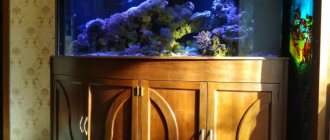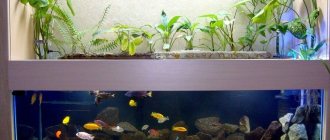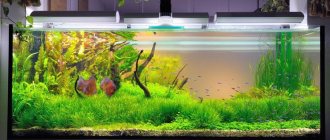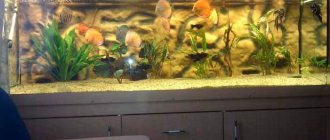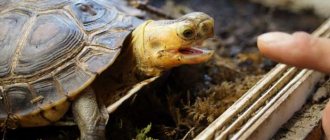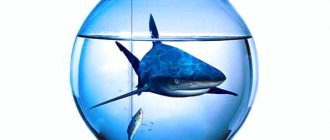How to create optimal parameters of the aquatic environment for a paludarium
How to grow strawberries from seeds: instructions for growing and caring for them at home (100 photos and videos) In order for aquarium inhabitants and green spaces to be healthy, beautiful, and fully developed, it is important to take care of creating the most comfortable conditions for their living in the paludarium:
Temperature mode When creating a paludarium, it is important to pay attention to the temperature of both the aquatic environment and the air in the space of the water garden. Optimal temperature indicators range from +24 to +28°C. You can maintain the temperature regime, avoiding its changes, using waterproof heaters equipped with an automatic thermostat, as well as pendant lamps located above the paludarium itself
Backlight
Most aquatic and emergent plant crops cannot tolerate exposure to ultraviolet rays. Therefore, when creating and installing a paludarium, care must be taken to ensure that it is out of sunlight. To provide the necessary lighting, pendant lamps or simple table lamps are used, which are installed on the sides of the water garden (this option is ideal for small structures). Experts advise using medium-power fluorescent lamps to illuminate the paludarium.
Water level. Whether the paludarium is filled with liquid is a purely individual question. Depending on the wishes of the aquarist, you can use a small amount of water, or, on the contrary, you can create an imitation of a miniature indoor lake in which decorative fish, frogs, mollusks, shrimp and even turtles can live.
Design and decoration can be anything depending on personal taste preferences. In most cases, when creating a paludarium, aquarists use natural decorative elements, such as various stones, driftwood, shells, and corals.
Humidity indicators
Since tropical plants are usually grown in a paludarium, it is important to maintain sufficiently high air humidity levels. For these purposes, you can use specialized spraying systems, miniature fountains and decorative waterfalls, which will also perform an additional decorative function.
Priming. For aquatic crops grown directly in an aquarium, fine soil covering the bottom of the tank with a layer of at least 5 cm is suitable. If you plan to plant greenery in separate containers located above an artificial reservoir, then preference should be given to peat soil, which is recommended beforehand. add some chopped tree bark.
Filtration and aeration are important primarily for ornamental fish and other aquarium inhabitants, although many plants need an increased amount of oxygen and cleanliness of the aquatic environment. Therefore, it is recommended to equip an artificial reservoir with a medium-power filter, as well as a small aerator. In order not to spoil the appearance of the paludarium, it is recommended to give preference to external models of filters and aerators, which should be fixed on the back walls of the artificial reservoir
It is also important to maintain cleanliness in the aquarium, not forgetting to change the liquid in the tank weekly, at least 30-40% of the total water volume
Ventilation is necessary for closed structures. In such paludariums, care should be taken to blow through the glass door by making small holes in it. Otherwise, the wall will fog up, which will not allow you to enjoy the beauty of the water garden.
What is needed to create a design
The basis for creating a paludarium at home is a traditional aquarium. In an artificial reservoir, two types of materials are used to create a specific background, each of which has its own characteristics, advantages and disadvantages:
- Foam for installation . You can make this material yourself by mixing foam with sand. The resulting solution must be placed in the so-called formwork, thanks to which certain patterns are formed. When the material hardens, it will be enough just to carefully file away the structure, eliminating unnecessary, superfluous parts. Then paint the background in the desired colors, using for these purposes high-quality paint without toxic substances in the composition, which can be detrimental to both green spaces and ornamental fish.
- Styrofoam. A piece of suitable shape and size should be cut from a large layer of foam plastic in accordance with the parameters of the artificial reservoir. A well-heated soldering iron will help give the background relief and patterning. In conclusion, all that remains is to paint the resulting base, following the recommendations described above.
If the paludarium is supposed to be placed above an artificial pond, which also looks very impressive, then a plywood box must be attached to the wall near which the water garden will stand. Next, containers intended for planting crops are fixed on it.
The shape of the structure itself resembles a cabinet with transparent glass doors, which are attached to a plywood base using special wooden or glass hinges and self-tapping screws.
The necessary conditions
There are special conditions, without which all the efforts you have spent on creating and decorating the paludarium will be in vain. Let's look at them in more detail.
Did you know? One of the representatives of exotic amphibians that can be grown in the paludarium, the Azureus tree frog,
secretes a very toxic poison that can cause heart rhythm disturbances even in adults. The Indians used this poison to lubricate their arrows before hunting.
Soil (ground)
You can use both universal soil with the addition of peat and charcoal, and special soil for aquariums and terrariums
Before use, it is important to carefully inspect the soil for the presence of microorganisms. To be sure to get rid of uninvited guests, you can bake it in the oven
Water
If only plants live in your paludarium, then there are no special requirements for water. It’s a different matter if you decide to populate it with pets: in this case, cleanliness is the main requirement for creating comfortable living conditions in the water. Pure water without impurities is suitable; if it comes from a tap, you need to let it sit for a couple of days.
This is done to remove the chlorine used to disinfect tap water. Also take care of purchasing a filter that will allow you to clean it more efficiently.
Find out how to determine water hardness and the optimal water temperature in your aquarium.
Lighting
Good lighting is one of the main principles of creating comfortable conditions for growing plants in a “home swamp”. You can understand which lighting is right for your paludarium using a simple calculation: at least 0.5 kV per 1 liter of its volume. Combined lighting has proven itself best - this is simultaneous illumination with fluorescent lamps and special lamps for plants. Phytolamps, due to their special glow in the violet and red spectrum, have a beneficial effect on the photosynthesis of plants and make their color more intense.
It should be remembered that the daylight hours for most plants do not exceed 12 hours, therefore, in order not to disrupt their metabolic processes, you must regularly turn the lamps on and off at the same time.
Temperature
Try not to let the temperature in the paludarium drop below 25°C; The upper temperature range is 35°C. If the temperature in summer is above 35°C, then irrigation of the plants should be increased. Don't forget that when you turn off the lights at night, the temperature drops a few degrees - this brings the situation closer to natural conditions.
Humidity
The main plant species living in paludariums are guests from tropical forests, so it is very important to maintain high humidity in it every day. You can do this either independently, spraying with water several times a day, or with the help of special irrigation systems or small fountains.. In the paludarium you can also keep a chameleon, tree frog, salamander, aquarium toad, tarantula spider, African snails, monitor lizard, scolopendra , gecko, royal python, newt, crocodile, iguana, butterflies, African hedgehog, sand boa, corn snake.
In the paludarium you can also keep a chameleon, a tree frog, a salamander, an aquarium toad, a tarantula spider, African snails, a monitor lizard, a centipede, a gecko, a royal python, a newt, a crocodile, an iguana, butterflies, an African hedgehog, a sand boa, and a corn snake.
How to properly care for pets
In order for ornamental fish and other representatives of aquatic fauna living in the paludarium to feel comfortable and live long, maintain health and delight the eye with their beauty, aquarists should follow the recommendations of experts:
- When filling the tank, take into account the compatibility factor of certain aquarium inhabitants.
- Use exclusively high-quality, nutritious feed.
- Carry out regular cleaning and filtration of the aquatic environment.
- Maintain stable humidity and temperature in the paludarium, avoiding sudden changes.
- Use distilled water and, if fungi and mold appear on the leaf plates of plants, promptly remove them, and then disinfect the paludarium.
- Promptly remove dried/damaged plant crops or their individual parts or leaf blades from the water garden.
- Periodically clean the glass of the water garden using specialized solutions for this purpose.
- From time to time, add fertilizers and mineral fertilizers to the soil, which are calculated according to an individual scheme, taking into account the specific type of green space growing in the paludarium.
- At least once every 2 weeks, replace the water in an artificial reservoir by at least 25-30% of the total volume of liquid.
Paludarium is an amazing corner of aquatic flora and fauna that can be placed at home. If earlier such water gardens, due to their high cost and rarity, were the privilege of only well-to-do people, now, using simple materials and a little effort, every interested aquarist can create a luxurious paludarium with his own hands. Moreover, judging by the reviews, such a paludarium brings much more joy and positive emotions than a ready-made water garden purchased in a store, because you can decorate it based solely on your personal taste preferences.
Fauna
Since the paludarium combines several habitats - underwater, terrestrial, coastal - its inhabitants can be different. You can put fish, frogs, turtles, and newts in it. Some types of insects and shellfish will take root well. The water indicators and the design features of the container depend on which population you choose for your paludarium.
https://youtube.com/watch?v=HBmzVpZaZyo
Paludarium is a unique opportunity to bring a little natural warmth into city life. Making it at home is actually not that difficult, and the positive emotions that watching a small tropical island will give you will be worth all the effort and money.
Difference from a regular aquarium
The main difference between an aquarium and a paludarium is that the first is completely filled with water, while the second provides for the presence of dry land. In addition, not only fish, but also reptiles, amphibians, insects and others can live in the paludarium. Another distinctive feature is that various types of plants, including flowering ones, can be grown in an open aquarium.
We create conditions
Its location plays a big role in the successful maintenance of a paludarium. He shouldn't stand in the sun! Otherwise, blue-green algae will not take long to appear. In addition, some plants suffer from excessive sunlight and will not be able to fully develop.
Before you start, check every detail: lamp, primer, sprayer and filters.
Soil and water
For plants that are planted in a pot, peat-based substrates are considered optimal. Regular aquarium soil is laid out on the bottom of the aquarium. But select the soil based on what plants and animals will live in the paludarium. The thickness of the layer at the front wall is at least 5 centimeters. As you rise to the “island” - the part protruding from the water - the layer thickens. The area of the island depends on the inhabitants of your paludarium. For example, turtles will require a lot of space, as will large amphibians.
The water in the aquarium must be settled and prepared in advance.
Temperature
The optimal water temperature in the paludarium ranges from 24-26 degrees. If this indicator is maintained indoors, there is no need to resort to additional heating. If the room temperature is lower, it is necessary to install a terrarium cord with a regulator. For uniform heating, you will need a pump with low power, which will ensure constant circulation of water.
The temperature should not rise above 30-35 degrees. In summer, when the temperature rises significantly, it is necessary to spray the plants daily to maintain humidity levels.
Humidity
Since most of the plants in the paludarium belong to tropical species, high humidity for them is a guarantee of a comfortable and fulfilling existence. Special spray systems will help maintain the desired level of humidity in the aquarium. You can purchase small waterfalls or fountains - they also humidify the air and are a wonderful decoration.
https://youtube.com/watch?v=TYDsYRWmMoQ
Ventilation
The downside of high humidity levels is foggy windows. They spoil the appearance of the corner and prevent you from seeing what is happening inside. Ventilation can be used to eliminate this problem. But it will dry out the air, so the plants will have to be sprayed more often, trying to maintain the moisture balance.
Filtration
The filter is necessary to a greater extent for animals. Fish, shellfish and most turtles prefer to feed in water, so pollution is inevitable. This means there is a need for cleaning and filtration.
Lighting
The most suitable lamp for paludariums is a fluorescent lamp. The required power is 0.5 watts per liter. Phytolamps will be useful, the spectrum of which has a positive effect on plants and accelerates photosynthesis. The cost of phytolamps is quite high, so it is better to combine them with ordinary ones.
Daylight hours for plants in a paludarium are within 10-12 hours. If you want to achieve flowering of some species, you will have to increase it to 14-16 hours.
Keeping lizards, turtles and other reptiles may require an incandescent lamp under which cold-blooded animals can bask.
When all conditions in the paludarium are met, the launch can begin.
Preparation
To assemble a paludarium, you will need a glass box - an aquarium. It is desirable that the front wall consists of a removable upper part. This is necessary for convenience when caring for plants. The size of the container depends on your wishes: if you dream of a real paradise island with a mini crocodile, the size of the container should be impressive. For fish and turtles, the volume of the paludarium depends on their species and, accordingly, size.
There is also a nano paludarium: a small container (up to 1-1.5 liters) in which a small plant island is created. This design is used as a decorative element and in some ways can be compared to bonsai trees.
In order for the corner to look beautiful, you need to choose the appropriate lamp. Not only the appearance, but also the health of plants depends on lighting.
Do-it-yourself terrarium for Achatina snails
The best house for the Achatina snail is easy to make. To do this, you need to buy glass, cut and glue a box of 4 walls, make a bottom and a lid. The top can be covered with veneer. The floor is made from chipboard. Place heating, holes for air and water. Curious snails taste everything and multiply quickly.
For caterpillars, housing is created according to the same principle; the distinctive feature is lighting and the presence of living plants on which the caterpillar will feed. For ants, terrariums should be built with maximum treatment with resin and putty on all cracks and holes for moisture and ventilation.
For the praying mantis, the construction concept is the same. The owner can put a pot with a live flower and place pebbles and a container of water at the bottom.
Paludarium is a swamp, but not quite
DIY craft from rowan berries. DIY rowan branch: we make our own interior decorations on the theme of nature. cucumbers with bunches of rowan
Paludariums are water gardens in the interior. Despite the fact that their name comes from the Latin paluda (swamp) and arium (place), they should not be considered just indoor swamps. The essence of these complex ecosystems, which are transparent reservoirs with an artificially created habitat for maintaining aquatic plants, is perfectly evidenced by their nicknames. Among gardeners, paludariums are known both as aquariums for plants, and as indoor swamps, and as water greenhouses or swamp terrariums.
In essence, a paludarium is a greenhouse enclosed in a vessel with high humidity conditions for specific moisture-loving crops, a kind of hybrid of a florarium and a portable pond or aquarium. Paludariums combine three elements - earth, air and water.
The paludarium is certainly an aesthetic and atmospheric object: it affects the mood in the same way as garden ponds and any other water bodies, bringing calm, relieving stress, relaxing, setting the mood for rest and promoting complete relaxation.
This is one of the most effective objects that harmonize space, which sets the mood and allows you to experience all the delights of communicating with nature without leaving your home. In fact, it is an original piece of aquatic plant life in your home. But paludariums have other advantages:
- they are one of the best means of air humidification, similar in effect to any industrial humidifier;
- despite their growing popularity, paludariums remain one of the most unusual and elite landscaping options;
- they allow you to realize the dream of your own water garden, even if you do not have a suburban area;
- You can grow the most capricious plants in them.
Paludariums allow you to imitate natural bodies of water or their individual fragments. Their arrangement is always guided by idealized landscapes - views of a flooded forest, floodplains, island stone beaches, river banks and mountain streams. Depending on your idea of an ideal water garden, paludariums can even imitate a waterfall, steep cliffs, ledges, and multi-level ponds.
Paludariums are an option for an aquatic florarium, which is suitable not only for those who love water gardens and objects and have experience in maintaining an aquarium. Of course, having some practical training will not hurt, but if you dream of your own paludarium, then with enough diligence you will achieve success even without experience. Moreover, aquarists will always be able to advise you.
But when deciding to start even a small paludarium, be prepared for the fact that you will have to take care of it: unlike a regular florarium, which stands out precisely for its ease of care, an aquatic terrarium requires constant attention.
Paludarium. gy960
Cryptocoryne
One of the most common aquarium plants from the araceae family is cryptocoryne. The plant is at the top of the pedestal among the favorites of aquarists because of its versatility and unpretentiousness. Externally, cryptocoryne, the photo of which is presented below, looks like a bush with long elongated stems and leaves. Their height varies from 4 to 100 cm. The types of leaf surfaces are different: smooth and pimply.
The name itself, consisting of two roots, crypto and koryne, tells about one of the features of this plant, which is partly its disadvantage. Cryptocoryne literally means “hidden cob.” In other words, in the foliage of this representative of aquarium plants lies a flower, which in extremely rare cases reaches its opening in paludarium conditions.
As already mentioned, the maintenance of cryptocorynes is absolutely not burdensome for the owners: they do not care how humidified the space around them is, how illuminated it is. However, although the plant is unpretentious, there is still one condition under which it may not have a sweet time. This is climate change. It is not recommended to move cryptocoryne from an illuminated area to the shade, change the composition of water or soil, or change the temperature regime. This can lead to plant disease and almost irreparable consequences. If this does happen, then it is urgent to change the water, soil, and remove infected leaves and algae.
You may be interested in: How to plant cacti? Methods for propagating cacti at home
In general, this green comrade, if you care for it properly, is the most reliable companion for those who like to breathe clean air at home.
Features of the paludarium
The contents of paludariums and aquariums have a lot in common, but still in the first case there are a number of features that connoisseurs of paludariums should definitely know.
Irrigation system
As we wrote above, high humidity is one of the main factors in creating the right conditions in a paludarium, so you cannot do without installing an appropriate system. The simplest, and at the same time the most convenient way is an automatic irrigation system. A time relay installed in the equipment turns on watering at a certain time of day and turns it off after the time you specify. This system works on the following principle: using a pump, water is drawn from a reservoir, passes through a filter and is sprayed from above onto the plants. This type of watering is very convenient because you do not need to spend additional time repeatedly irrigating plants.
Among the disadvantages, the following can be noted - filtered water contains salts and microorganisms, which, after contact with plants, can leave white spots and also interfere with their free breathing. As an option for irrigation in a closed type - spraying water from a spray bottle manually. But this method is not entirely convenient for owners of large containers, and also leaves streaks on the glass.
If you have an open paludarium, you probably noticed that the moisture in the air quickly evaporates. Additional installation of fog heads or sprinklers will help you maintain a high level of humidity
Important! If you have a paludarium with high walls, then most likely the soil at the bottom does not have time to warm up to the required temperature - this can cause slow growth and deterioration in the appearance of the plants. For additional heating of the soil, it is best to install thermal cords
They can be purchased at any zoological store.
Ventilation
In closed-type ecosystems, there is one peculiarity - condensation can form on the front glass, which interferes with the view and gives the paludarium an unaesthetic appearance. One of the reasons is the difference in temperature and humidity in the room and behind the glass. Only enhanced ventilation can cope with this - for example, a removable front wall. If your paludarium is large, then the front wall is divided into several parts that can be attached with magnets.
In open ecosystems, ventilation problems do not arise.
Filtration
Water filtration is a must for keeping fish and other aquatic animals, especially if the volume of your aquarium exceeds 20 liters. The principles for installing filters in a paludarium are the same as in an aquarium. Let's look at them in more detail.
There are three main types of water filtration:
- Mechanical - installation of a special filter or sponge that “absorbs” large debris and waste from the inhabitants of the aquatic environment.
Chemical - filtration of substances dissolved in water and their molecules before the process of their decomposition begins; filters and purification columns based on activated carbon and zeolite are used.
Biological - water purification using bacteria that convert ammonia compounds into non-toxic nitrates and are also capable of absorbing organic debris. This type of cleansing can be done by underwater plants and algae.
To achieve better results in water purification in a paludarium, you can combine types of filtration. The type of water purification primarily depends on the inhabitants of the ecosystem you have created.
Fish and living population
Animals are rarely kept in paludariums. In the aquatic part of a composition such as “German aquarium”, “steep shore” or “wave”, viviparous or spawning fish, labyrinth fish (macropods, gouramis, natural species of cockerels) and other inhabitants of reservoirs with low water levels look natural and beautiful. In a paludarium of the “tropical forest” type, the reservoir is, as a rule, not populated, although there are exceptions: sometimes nano-fish such as the “Galaxy” microrasbora or Endler’s guppies are placed in the “puddle” of such a paludarium. Nanopaludariums and vabicus are uninhabited.
Above the water, in the “steep shore” and “tropical forest” paludariums, you can house small tropical amphibians: colorful exotic frogs, heat-loving species of newts. Sometimes small moisture-loving reptiles are stocked in the “tropical forest” paludarium.
The necessary conditions
There are special conditions, without which all the efforts you have spent on creating and decorating the paludarium will be in vain. Let's look at them in more detail.
Did you know? One of the representatives of exotic amphibians that can be grown in the paludarium, the Azureus tree frog, secretes a very toxic poison that can cause heart rhythm disturbances even in adults. The Indians used this poison to lubricate their arrows before hunting.
Soil (ground)
You can use both universal soil with the addition of peat and charcoal, and special soil for aquariums and terrariums
Before use, it is important to carefully inspect the soil for the presence of microorganisms. To be sure to get rid of uninvited guests, you can bake it in the oven
Water
If only plants live in your paludarium, then there are no special requirements for water. It’s a different matter if you decide to populate it with pets: in this case, cleanliness is the main requirement for creating comfortable living conditions in the water. Pure water without impurities is suitable; if it comes from a tap, you need to let it sit for a couple of days.
This is done to remove the chlorine used to disinfect tap water. Also take care of purchasing a filter that will allow you to clean it more efficiently.
Find out how to determine water hardness and the optimal water temperature in your aquarium.
Lighting
Good lighting is one of the main principles of creating comfortable conditions for growing plants in a “home swamp”. You can understand which lighting is right for your paludarium using a simple calculation: at least 0.5 kV per 1 liter of its volume. Combined lighting has proven itself best - this is simultaneous illumination with fluorescent lamps and special lamps for plants. Phytolamps, due to their special glow in the violet and red spectrum, have a beneficial effect on the photosynthesis of plants and make their color more intense.
It should be remembered that the daylight hours for most plants do not exceed 12 hours, therefore, in order not to disrupt their metabolic processes, you must regularly turn the lamps on and off at the same time.
Temperature
Try not to let the temperature in the paludarium drop below 25°C; The upper temperature range is 35°C. If the temperature in summer is above 35°C, then irrigation of the plants should be increased. Don't forget that when you turn off the lights at night, the temperature drops a few degrees - this brings the situation closer to natural conditions.
Humidity
The main plant species living in paludariums are guests from tropical forests, so it is very important to maintain high humidity in it every day. You can do this either independently, spraying it with water several times a day, or with the help of special irrigation systems or small fountains.
In the paludarium you can also keep a chameleon, a tree frog, a salamander, an aquarium toad, a tarantula spider, African snails, a monitor lizard, a centipede, a gecko, a royal python, a newt, a crocodile, an iguana, butterflies, an African hedgehog, a sand boa, and a corn snake.
SURFACE STRUCTURE
To grow plants above the water level, they will need something in which they can take root, so first you need to make a structure on which you can place the soil. Some aquatic designers use rocks to create the basic shape: volcanic rock is especially good for paludariums because it can support plants and is light enough to pile up. Others use expandable polyurethane foam to create a cover that can be customized to fit any desired design. Creating your own foam backdrop allows you to create "depressions" and "canyons" that can be filled with soil for growing plants. Once the structure is in its intended position, it can be covered with plant-rooting fiber, such as compressed coconut fiber, which will maintain moisture and allow plants to take root.
Decor
The design of the paludarium begins with the creation of the back wall. There are several options.
- Ready background. Special panels of different sizes or even a ready-made composition can be purchased in the store.
- Styrofoam. If you want to do it yourself, you can use foam. Take a piece of foam the size of the wall of an aquarium. Using a soldering iron, the desired relief is created. After this, the background must be treated with non-toxic paints or adhesives. The color of the paint can imitate stone - from gray tones to dark brown. Small pebbles, sand, pieces of bark and other materials are poured onto the glue. The panel is placed in the aquarium, attached to the glass with silicone sealant.
- Cardboard box. In this case, the panel will be placed not inside, but outside the aquarium, on the back wall. A cardboard box is made to size, painted on the inside with the desired colors. It can also be covered with colored paper and other materials. Twigs, pieces of bark, and stones are placed inside the box. This background has one drawback: in order for it to always look impressive, you need to regularly clean the rear window.
- Polyurethane foam. To make a foam panel, you will need plastic film. It is spread out on a flat surface, and then foam is applied to it - so that the desired relief is obtained. After the foam dries, a finished panel is obtained. Protrusions and irregularities are cut off with a knife. After this, remove the film, cover the panel with epoxy resin or waterproof paint and place it in the aquarium.
- Stones. You will need stones of different sizes and a piece of plexiglass. Using a sealant, the stones are glued to the glass. The voids can be filled with the same foam, epoxy resin and other materials. If you want to decorate your aquarium with stones, try to choose lighter rocks.
- Combination. Nobody prohibited the use of several design options at once. You can decorate a paludarium using a cardboard box and polystyrene foam, stones and foam - it all depends on your imagination and design idea.
Decorative elements
As decorative elements, you can use the same materials that are placed in a classic aquarium: driftwood, branches, stones.
When using branches and snags collected by yourself, do not forget about safety. Before immersing them in water, they must be properly boiled so as not to introduce dangerous microorganisms into the paludarium environment. Decorations purchased at a pet store can be immediately installed in the container.
Stones and driftwood will look even more impressive if you add suitable plants to them - for example, anubias or Java moss. By the way, in pet stores you can find decorative elements for the aquarium that are already covered with moss.
Return to content

